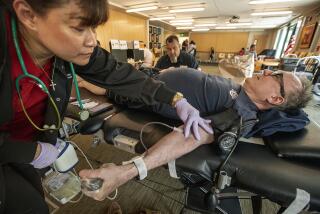Nation’s Blood Supply in Danger of Drying Up
- Share via
WASHINGTON — Americans take for granted they’ll get a blood transfusion whenever they need one, but soon that may not be the case: Blood donations are dropping so low that serious, nationwide shortages could hit as early as next year, officials say.
The government is so concerned that Surgeon General David Satcher has a committee hunting ways to get more people to donate blood more often, studying such incentives as giving donors time away from work or small rewards like T-shirts.
And some blood banks have started creative programs to lure donors--one in Iowa even gives puppet shows and science demonstrations to students, grooming them to donate as soon as they turn 17.
“We operate on a very thin margin of safety for the blood supply, and if that trend continues it would put us in a year-round shortage in a few years,” said Dr. Arthur Caplan of the University of Pennsylvania, who heads a federal committee on blood issues.
The National Blood Data Resource Center is more pessimistic: Its studies predict that next year, Americans will donate just under 11.7 million units of blood--but that hospitals will need 11.9 million units.
Blood donations are decreasing about 1% a year. Demand for blood is increasing by 1% a year.
Already, some cities routinely experience temporary blood shortages during holidays like the Fourth of July weekend and the summer, when regular blood donors go on vacation.
Adding to the pressure, the government soon will ban Americans from giving blood if they have traveled extensively in Great Britain--trips that added together total six months since Britain’s mad cow disease epidemic began in 1980. Mad cow disease has been linked to a human brain destroyer, so experts want the precaution of a donor ban even though there’s no proof that any mad cow-type illness could spread through human blood. But a ban would cut the blood supply another 2.2% a year.
“When you need surgery, when you need cancer treatment, when a woman gives birth--we all assume the blood will be there,” Caplan said. “You can’t make that assumption anymore.”
His committee just recommended one change that could provide up to 300,000 more pints a year: Use blood from people with a genetic disease called hemochromatosis that causes them to build up too much iron. Giving blood regularly alleviates iron buildup. That blood is healthy, but today it’s thrown away because it’s a medical treatment that patients pay for--donations must be altruistic.
Why are donations dropping? Nobody really knows, although blood banks say younger generations have never shown the enthusiasm of post-World War II donors. About 60% of Americans are estimated to be eligible donors but only 5% donate.
It’s partly convenience and being reminded that blood is needed, said Satcher.
Even “when I give blood, it’s in the context of the Red Cross coming around to where you work,” he said. “There are people who would donate at least twice as much if they knew they were needed.”
The Central Florida Blood Bank proved that Satcher’s right: It created an automated program that leaves messages--recorded by an Orlando TV personality--on previous donors’ answering machines saying, “Please donate blood this week.” Last Memorial Day, a typical shortage period, the RealCall program prompted a 16% donation response.
The Mississippi Valley Regional Blood Center in Davenport, Iowa, gives puppet shows in hopes of grooming schoolchildren to become donors later in life--and hook their parents too.
“Joey scraped his knee, so I raced right over,” said Paula Platelet in a skit explaining how platelets help clot blood. Other skits feature Whitey White Cell and Penelope Plasma.
When kids get older, blood bank workers visit science classes yearly to explain donations and transfusions, and test students’ blood type.
They can’t yet measure the puppets’ effects. But the first students to get yearly science-class visits turned 17 last year, and the annual high school blood drive showed a 23% increase in first-time donors.
Blood banks hope that Satcher’s advisors will consider such programs in looking for ways to replace the donors who will be lost under the pending British travel ban.
In addition, Rep. Thomas Bliley (R-Va.) just asked the General Accounting Office to study how serious the shortage is, questioning the impact of that ban and of hemochromatosis donations.
More to Read
Sign up for Essential California
The most important California stories and recommendations in your inbox every morning.
You may occasionally receive promotional content from the Los Angeles Times.













